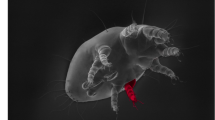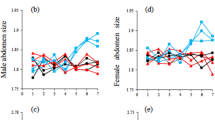Abstract
Evolutionary theory predicts the depletion of genetic variation in natural populations as a result of the effects of selection, but genetic variation is nevertheless abundant for many traits that are under directional or stabilizing selection1. Evolutionary geneticists commonly try to explain this paradox with mechanisms that lead to a balance between mutation and selection2. However, theoretical predictions of equilibrium genetic variance under mutation–selection balance are usually lower than the observed values, and the reason for this is unknown3. The potential role of sexually antagonistic selection in maintaining genetic variation has received little attention in this debate, surprisingly given its potential ubiquity in dioecious organisms. At fitness-related loci, a given genotype may be selected in opposite directions in the two sexes. Such sexually antagonistic selection will reduce the otherwise-expected positive genetic correlation between male and female fitness4. Both theory5,6,7 and experimental data8,9,10,11,12 suggest that males and females of the same species may have divergent genetic optima, but supporting data from wild populations are still scarce13,14,15. Here we present evidence for sexually antagonistic fitness variation in a natural population, using data from a long-term study of red deer (Cervus elaphus). We show that male red deer with relatively high fitness fathered, on average, daughters with relatively low fitness. This was due to a negative genetic correlation between estimates of fitness in males and females. In particular, we show that selection favours males that carry low breeding values for female fitness. Our results demonstrate that sexually antagonistic selection can lead to a trade-off between the optimal genotypes for males and females; this mechanism will have profound effects on the operation of selection and the maintenance of genetic variation in natural populations.
This is a preview of subscription content, access via your institution
Access options
Subscribe to this journal
Receive 51 print issues and online access
$199.00 per year
only $3.90 per issue
Buy this article
- Purchase on Springer Link
- Instant access to full article PDF
Prices may be subject to local taxes which are calculated during checkout


Similar content being viewed by others
References
Merila, J., Sheldon, B. C. & Kruuk, L. E. B. Explaining stasis: microevolutionary studies in natural populations. Genetica 112, 199–222 (2001)
Barton, N. H. & Keightley, P. D. Understanding quantitative genetic variation. Nature Rev. Genet. 3, 11–21 (2002)
Turelli, M. & Barton, N. H. Polygenic variation maintained by balancing selection: Pleiotropy, sex-dependent allelic effects and G × E interactions. Genetics 166, 1053–1079 (2004)
Lynch, M. & Walsh, B. Genetics and Analysis of Quantitative Traits (Sinauer, Sunderland, Massachusetts, 1998)
Hedrick, P. W. Antagonistic pleiotropy and genetic polymorphism: a perspective. Heredity 82, 126–133 (1999)
Rice, W. R. & Chippindale, A. K. Intersexual ontogenetic conflict. J. Evol. Biol. 14, 685–693 (2001)
Rice, W. R. Sex chromosomes and the evolution of sexual dimorphism. Evolution Int. J. Org. Evolution 38, 735–742 (1984)
Chippindale, A. K., Gibson, J. R. & Rice, W. R. Negative genetic correlation for adult fitness between sexes reveals ontogenetic conflict in Drosophila. Proc. Natl Acad. Sci. USA 98, 1671–1675 (2001)
Fedorka, K. M. & Mousseau, T. A. Female mating bias results in conflicting sex-specific offspring fitness. Nature 429, 65–67 (2004)
Rice, W. R. Sexually antagonistic genes: experimental evidence. Science 256, 1436–1439 (1992)
Gibson, J. R., Chippindale, A. K. & Rice, W. R. The X chromosome is a hot spot for sexually antagonistic fitness variation. Proc. R. Soc. Lond. B 269, 499–505 (2002)
Meagher, T. R. The quantitative genetics of sexual dimorphism in Silene latifolia (Caryophyllaceae). 1. Genetic variation. Evolution Int. J. Org. Evolution 46, 445–457 (1992)
Forsman, A. Opposing fitness consequences of colour pattern in male and female snakes. J. Evol. Biol. 8, 53–70 (1995)
Calsbeek, R. & Sinervo, B. Within-clutch variation in offspring sex determined by differences in sire body size: cryptic mate choice in the wild. J. Evol. Biol. 17, 464–470 (2004)
Robinson, M. R., Pilkington, J. G., Clutton-Brock, T. H., Pemberton, J. M. & Kruuk, L. E. B. Live fast, die young: Trade-offs between fitness components and sexually antagonistic selection on weaponry in Soay sheep. Evolution Int. J. Org. Evolution 60, 2168–2181 (2006)
Rice, W. R. Dangerous liaisons. Proc. Natl Acad. Sci. USA 97, 12953–12955 (2000)
Coulson, T. et al. Estimating individual contributions to population growth: evolutionary fitness in ecological time. Proc. R. Soc. Lond. B 273, 547–555 (2006)
Sokal, R. R. & Rohlf, F. J. Biometry 3rd edn (Freeman, New York, 1995)
Kruuk, L. E. B. Estimating genetic parameters in natural populations using the ‘animal model’. Phil. Trans. R. Soc. Lond. B 359, 873–890 (2004)
Kruuk, L. E. B. et al. Heritability of fitness in a wild mammal population. Proc. Natl Acad. Sci. USA 97, 698–703 (2000)
Houle, D. Comparing evolvability and variability of quantitative traits. Genetics 130, 195–204 (1992)
Kruuk, L. E. B. et al. Antler size in red deer: heritability and selection but no evolution. Evolution Int. J. Org. Evolution 56, 1683–1695 (2002)
Kokko, H. Fisherian and ‘good genes’ benefits of mate choice: how (not) to distinguish between them. Ecol. Lett. 4, 322–326 (2001)
Pischedda, A. & Chippindale, A. K. Intralocus sexual conflict diminishes the benefits of sexual selection. PLoS Biol. 4, e356 (2006)
Clutton-Brock, T. H., Guinness, F. E. & Albon, S. D. Red Deer: Behavior and Ecology of Two Sexes (Univ. of Chicago Press, Chicago, 1982)
Kruuk, L. E. B., Clutton-Brock, T. H., Rose, K. E. & Guinness, F. E. Early determinants of lifetime reproductive success differ between the sexes in red deer. Proc. R. Soc. Lond. B 266, 1655–1661 (1999)
Coulson, T., Albon, S., Guinness, F., Pemberton, J. & Clutton-Brock, T. Population substructure, local density, and calf winter survival in red deer (Cervus elaphus). Ecology 78, 852–863 (1997)
Marshall, T. C. et al. Estimating the prevalence of inbreeding from incomplete pedigrees. Proc. R. Soc. Lond. B 269, 1533–1539 (2002)
Gilmour, A. R., Gogel, B. J., Cullis, B. R., Welham, S. J. & Thompson, R. ASReml User Guide 1.0. (VSN International, Hemel Hempstead, 2002)
Metcalf, C. J. E. & Pavard, S. Why evolutionary biologists should be demographers. Trends Ecol. Evol. 22, 205–212 (2007)
Clutton-Brock, T. H., Guinness, F. E. & Albon, S. D. The costs of reproduction to red deer hinds. J. Anim. Ecol. 52, 367–383 (1983)
Acknowledgements
We thank F. Guinness, A. Donald, S. Morris and many other project field workers; K. Connaghan, K. Byrne, S. Lewis, D. Nussey and J. Slate for genotyping work; and D. Nussey and A. Wilson for comments on earlier drafts of the manuscript. We thank Scottish Natural Heritage for permission to work on the Isle of Rum and their local staff for help and support. This work was funded by the Natural Environment Research Council, the Royal Society, and a Marie Curie European Fellowship.
Author Contributions The idea for this study originated from discussions between L.E.B.K., B.C.S. and K.F. The data used stem from a long-term study run by T.H.B.C., with involvement from L.E.B.K. and J.M.P.; J.M.P. was also responsible for the molecular paternity analysis. K.F. conducted all data analyses and drafted the manuscript. L.K. helped with the quantitative genetics analyses, and T.C. helped in applying the de-lifing approach. All authors discussed the results and commented on the manuscript.
Author information
Authors and Affiliations
Corresponding authors
Ethics declarations
Competing interests
Reprints and permissions information is available at npg.nature.com/reprintsandpermissions. The authors declare no competing financial interests.
Supplementary information
Supplementary Information 1
This file contains Supplementary Notes with the analysis of lifetime reproductive success (LRS), a more traditional fitness measure. The Supplementary Table S1 presents variance components, heritability, coefficients of additive genetic variation, and the inter-sexual genetic correlation of LRS. These results are compared with those obtained for the de-lifing measure pt(i). (PDF 98 kb)
Rights and permissions
About this article
Cite this article
Foerster, K., Coulson, T., Sheldon, B. et al. Sexually antagonistic genetic variation for fitness in red deer. Nature 447, 1107–1110 (2007). https://doi.org/10.1038/nature05912
Received:
Accepted:
Published:
Issue Date:
DOI: https://doi.org/10.1038/nature05912
This article is cited by
-
Genetic correlations of direct and indirect genetic components of social dominance with fitness and morphology traits in cattle
Genetics Selection Evolution (2023)
-
The roles of sexual selection and sexual conflict in shaping patterns of genome and transcriptome variation
Nature Ecology & Evolution (2023)
-
Polyandry and non-random fertilisation maintain long-term genetic diversity in an isolated island population of adders (Vipera berus)
Heredity (2023)
-
Differential effects of steroid hormones on levels of broad-sense heritability in a wild bird: possible mechanism of environment × genetic variance interaction?
Heredity (2022)
-
Genomic evidence that a sexually selected trait captures genome-wide variation and facilitates the purging of genetic load
Nature Ecology & Evolution (2022)
Comments
By submitting a comment you agree to abide by our Terms and Community Guidelines. If you find something abusive or that does not comply with our terms or guidelines please flag it as inappropriate.



